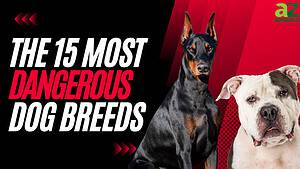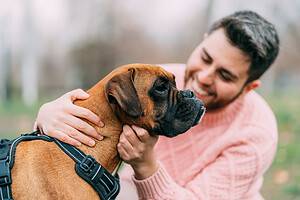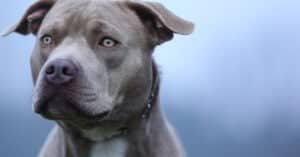Bulldogs are perhaps one of the most misunderstood dog breeds. They might seem scary and aggressive because of their grumpy, wrinkled faces, but they are friendly. Bulldogs make the best pet dog for city living, apartment living, and families with kids. Bulldogs are suitable for human companionship, and they can be funny and cuddly too. Despite being friendly, muscular, and strong, Bulldogs are still vulnerable to diseases, and their dental health is not an exception. Bulldog teeth sport sharp canines like most dog breeds do, which can sting when they bite. However, unlike other dog breeds, Bulldogs can have a tighter bite as they have mighty jaws that can lock together.
Apart from their grim facade, the idea of Bulldogs being aggressive dates back a long time ago, as they were originally used in competing with other Bulldogs in a sport called bull baiting. Thankfully, Bulldogs are now cared for and are treated as part of many families. Like most dog breeds, Bulldogs need extreme care, too, especially when it comes to their dental hygiene. Bulldogs can live up to 13 years or longer, and they need proper dental care along with sustenance.
What Kind of Teeth Do Bulldogs Have?
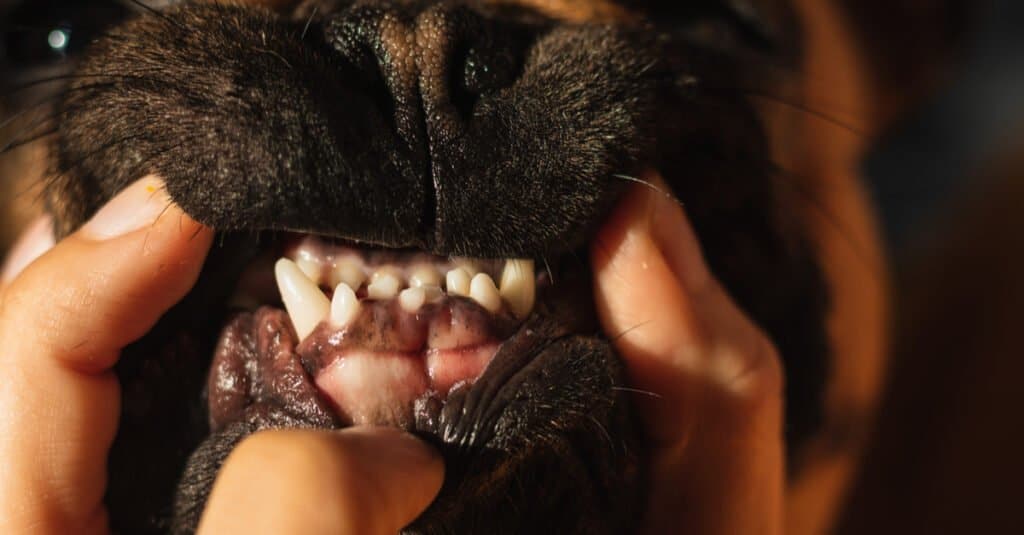
Bulldogs have heteredont teeth sharp enough to tear and cut through flesh.
©Pau Novell Aran/Shutterstock.com
Like all domesticated dog breeds, Bulldogs have a complete set of heterodont teeth, including incisors, canines, premolars, and molars. Bulldogs are diphyodont, which means they only grow two sets of teeth throughout their lifetime. A few weeks after birth, a deciduous set of teeth or milk teeth will erupt, which permanent teeth will replace as the Bulldog ages.
As expected, Bulldog teeth are sharp, especially the canines. Naturally, canids have long and sharp canine teeth that resemble fangs, helping them tear and cut through flesh. But since domesticated dogs have evolved to eat dog food and other soft or pre-sliced meals, they use their teeth more often on chewing toys and other things, tearing hard pieces of meat in their food, and biting when needed. Bulldogs can sometimes nip or chew on their owner’s fingers, and their sharp canines can sometimes puncture the flesh, especially while teething.
How Many Teeth Do Bulldogs Have?
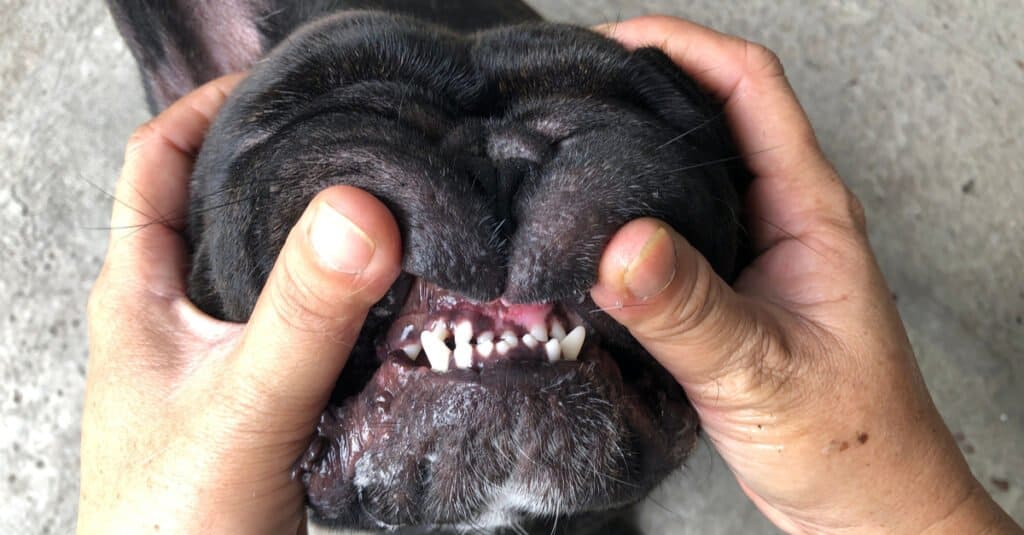
Bulldogs have 42 teeth.
©praditkhorn somboonsa/Shutterstock.com
Despite their seemingly tiny mouths, adult Bulldogs have 42 teeth, including 20 teeth in the upper jaw and 22 teeth in the lower mandible. Adult bulldogs have a total of 12 incisors, 4 canines, 16 premolars, and 10 molars. A typical Bulldog dentition is as follows: 2 (Incisors 3/3, Canines 1/1, Premolars 4/4, Molars 2/3) = 42. Puppy Bulldogs, however, only have 28 deciduous teeth or milk teeth.
Incisors: Bulldogs have a total of 6 pairs of front teeth in both the top and bottom jaws. The first two incisors at the upper jaw are somehow pointed, while the rest are tiny and flat-edged, which they use to scrape and gnaw food and other things.
Canines: It is a shared characteristic of the large group of canids to have two pairs of sharp canines or fangs located on both the upper and lower jaw. The Bulldog’s canines are long and pointed, which adds to the impact of their bites. Bulldogs use their canine teeth in tearing food, especially tough ones like meat. They are also sharp enough to puncture flesh.
Premolars: Bulldogs use their premolars in chewing and shredding food, wooden sticks, and chewing toys. Since canids are originally carnivores, the edges of the Bulldog’s premolars are sharp (carnassial teeth) and are devised for cutting meat. Bulldogs have 8 of these premolars both on the upper and lower jaw.
Molars: Molars are grinding teeth, and Bulldogs use them to crush their food into smaller pieces. They have 4 of these molars in the upper jaw and 6 of them in the lower mandible. These molars also have flat crowns which aid Bulldogs in breaking down their meal.
Bulldog Teething
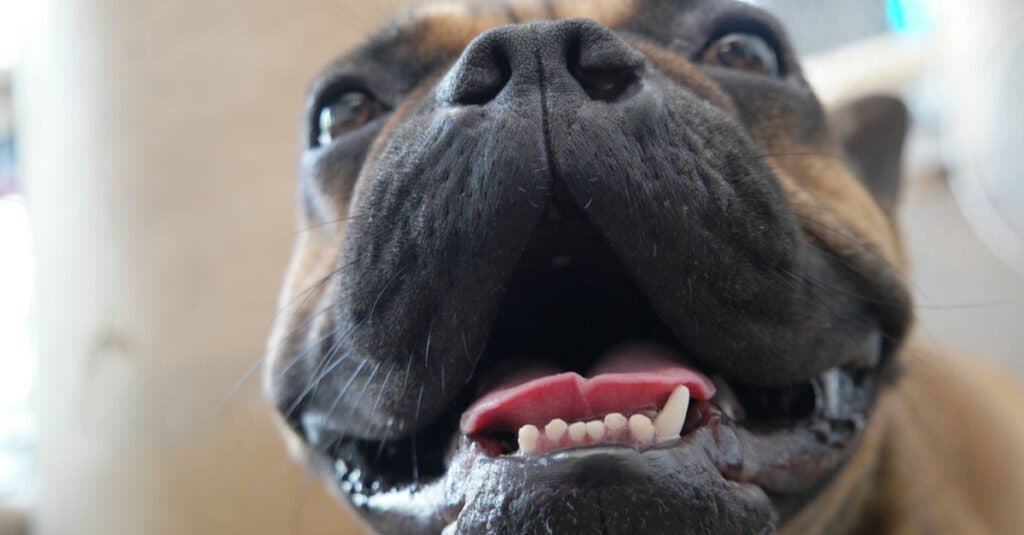
As diphyodonts, Bulldogs grow two sets of teeth in their lifetime.
©praditkhorn somboonsa/Shutterstock.com
Like any other dog breed, Bulldogs grow two sets of teeth in one lifetime – a deciduous set of teeth and a permanent set. The deciduous teeth or baby teeth erupt at about 2 to 3 weeks. At about 12 weeks or older, the Bulldog’s baby teeth will start to fall out and will start growing its adult or permanent teeth. This process is known as teething. At about 6 to 7 months of age, the teething process will stop, and the Bulldog will have its complete set of permanent teeth.
There are signs that will indicate the Bulldog has reached its teething stage. These signs include excessive drooling, constant chewing, loose milk teeth, flopped ears, and sore gums. Due to their swollen gums during the teething stage, they will often chew and bite on things, including hands or fingers, to relieve their discomfort. At this stage, chewing toys and frozen snacks will be a huge help.
Bulldog Bite Force
Bulldogs do not often bite for aggressive reasons, but it can be pretty rough when they do. The American Bulldog alone has one of the strongest bite forces in dogs, generating up to 305 PSI. Their muscular jaws are a tremendous help to this, added by their habit of locking their jaws after a bite. When provoked, Bulldogs can bite and can severely harm a person.
Common Dental Issues in Bulldogs
Bulldogs are vulnerable to tooth diseases and other dental problems, so proper dental hygiene and regular check-up are necessary to keep the Bulldog’s overall health good. Bad dental hygiene affects the bulldog’s mouth and its feeding and can even reach its body organs.
Plaque and tartar is a common problem for many dog breeds that often results from not having enough cleaning. Bacteria left by meals inside the Bulldog’s mouth can mix with its saliva and later cause tooth decay or gum irritation. This can eventually lead to gingivitis, where the bacteria consumes the tissues and the bone holding the teeth together, which then can lead to periodontal disease, where teeth fall out. Once this happens in their adulthood, their teeth can never grow back.
The photo featured at the top of this post is © Little Moon/Shutterstock.com
Ready to discover the top 10 cutest dog breeds in the entire world?
How about the fastest dogs, the largest dogs and those that are -- quite frankly -- just the kindest dogs on the planet? Each day, AZ Animals sends out lists just like this to our thousands of email subscribers. And the best part? It's FREE. Join today by entering your email below.
Thank you for reading! Have some feedback for us? Contact the AZ Animals editorial team.



